The Use of Nature-Based Solutions in the Adaptation of Large Polish Cities to Climate Change and Energy Transformation: A Comparative Analysis
Abstract
1. Introduction
1.1. Context of the Issue and Purpose of the Research
1.2. State of Research
1.3. URBAN GreenUP: Innovative NbS in European Cities
1.4. Strategic Planning of Poland’s Urban Adaptation Policy
2. Materials and Methods
- Re-naturing urbanisation:
- Arboreal interventions: planting and renewing urban trees, cooling trees, shade trees, arboreal areas around urban areas, trees re-naturing parking, urban carbon sink;
- Pocket parks and parklets;
- Green resting areas;
- Cycle and pedestrian green routes.
- Water interventions:
- Flood control infrastructure investments: rivers and channels re-naturalisation; flood actions: floodable parks, hard drainage-flood prevention, urban catchment forestry;
- Green pavements: cool pavement, cycle-pedestrian green paths, green parking pavements, hard drainage pavements;
- Pollution-filtering areas: natural wastewater treatment, green filter area;
- Drainage systems: rain gardens, grassed swales and water retention pounds, sustainable drainage systems (SUDSs).
- Singular green infrastructure:
- Vertical activities: green walls, hydroponic green facades, green facades with climbing plants, vertical gardens, green noise barriers, green fences;
- Horizontal activities: green roofs, green shady structures, green covering shelters, electro wetlands, floating gardens;
- Urban farming: small-scale urban livestock, community composting, urban orchards, climate-smart greenhouses;
- Pollutants filters: urban garden bio-filters; green filter areas;
- Pollinators: compacted pollinator modules, natural pollinator modules, pollinator roofs, pollinator walls, pollinator verges and spaces;
- Smart soils: smart soil as substrate, smart soil production in climate-smart urban farming precinct, enhanced nutrient managing and releasing soil.
3. Results
3.1. NbS for Polish Urban Areas
3.2. Comparative Study of the Use of NbS in the Scale of Poland
4. Discussion
4.1. The Use of NbSs in the Context of the URBAN GreenUP Project
- Reducing CO2 emissions and reducing air pollution;
- Reducing the impact of urban heat islands;
- Increasing biodiversity;
- Supporting the process of shaping the city’s ecological system;
- Shaping recreation and leisure spaces;
- Increasing land and property values;
- Reducing stress levels and increasing positive impact on the health and quality of life of residents.
4.2. Further Research Directions
5. Conclusions
- Lack of a holistic approach to the full range of ecosystem services that NbSs bring;
- A small share of innovative solutions, based on new technologies;
- A small share of solutions that generate clean energy;
- Insufficient knowledge, lack of understanding, and organisational and financial unpreparedness for planning and implementing NbSs among local governments;
- Low awareness and lack of public education.
- Reviewing and updating of urban adaptation plans, programmes, and strategies with regard to the application of NbSs;
- Developing planning and urban planning guidelines for shaping urban spaces using NbSs;
- Linking systemic actions that take into account NbSs, with singular actions, expanding the scope of applied solutions;
- Investing in cutting-edge research and innovation;
- Realising more efficient use of energy and resources in NbSs;
- Building systems for collecting data and monitoring implemented solutions;
- Conducting educational and promotional activities;
- Implementing new forms of organisation and management to NbSs;
- Securing adequate financial resources in city budgets;
- Strengthening the creativity of local authorities and the participation of residents.
Author Contributions
Funding
Data Availability Statement
Conflicts of Interest
References
- Mumford, L. The City in History: Its Origins, Its Transformations, and Its Prospects; Harcourt, Brace and World: New York, NY, USA, 1961. [Google Scholar]
- Kostof, S. The City Shaped: Urban Patterns and Meanings Through History; A Bulfinch Press Book: Belfast, UK; Little, Brown and Company: Boston, MA, USA, 1999. [Google Scholar]
- Pancewicz, A. Planning and strategic tools for adapting urban areas to climate change in Poland. Archit. Civ. Eng. Environ. 2021, 4, 31–44. [Google Scholar] [CrossRef]
- Albert, C.; Spangenberg, J.H.; Schröter, B. Nature-based solutions: Criteria. Nature 2017, 543, 315. [Google Scholar] [CrossRef] [PubMed]
- Eggermont, H.; Balian, E.; Azevedo, J.M.N.; Beumer, V.; Brodin, T.; Claudet, J.; Fady, B.; Grube, M.; Keune, H.; Lamarque, P.; et al. Nature-based Solutions: New Influence for Environmental Management and Research in Europe. GAIA Ecol. Perspect. Sci. Soc. 2015, 24, 243–248. [Google Scholar] [CrossRef]
- IUCN. Global Standard for Nature-Based Solutions: A User-Friendly Framework for the Verification, Design and Scaling up of NbS, 1st ed.; IUCN: Gland, Switzerland, 2020. [Google Scholar] [CrossRef]
- URBAN GreenUP. European Union’s Horizon 2020 Programme. Available online: https://www.urbangreenup.eu/ (accessed on 15 March 2023).
- World Bank. Biodiversity, Climate Change, and Adaptation: Nature-Based Solutions from the World Bank Portfolio; World Bank: Washington, DC, USA, 2008; Available online: http://hdl.handle.net/10986/6216 (accessed on 21 April 2023).
- European Commission, Directorate-General for Research and Innovation. Towards an EU Research and Innovation Policy Agenda for Nature-Based Solutions & Re-Naturing Cities: Final Report of the Horizon 2020 Expert Group on ‘Nature-Based Solutions and Re-Naturing Cities’: (Full Version); Publications Office. 2015. Available online: https://data.europa.eu/doi/10.2777/479582 (accessed on 21 April 2023).
- European Commission, Directorate-General for Research and Innovation; Bulkeley, H.; Naumann, S.; Vojinovic, Z.; Calfapietra, C.; Whiteoak, K.; Freitas, T.; Vandewoestijne, S.; Wild, T. Nature-Based Solutions: State of the Art in EU-Funded Projects; Freitas, T., Vandewoestijne, S., Wild, T., Eds.; Publications Office of the European Union: Luxembourg, 2020; Available online: https://data.europa.eu/doi/10.2777/236007 (accessed on 21 April 2023).
- Zwierzchowska, I.; Fagiewicz, K.; Poniży, L.; Lupa, P.; Mizgajski, A. Introducing nature-based solutions into urban policy—facts and gaps. Case study of Poznań. Land Use Policy 2019, 85, 161–175. [Google Scholar] [CrossRef]
- Albert, C.; Brillinger, M.; Guerrero, P.; Gottwald, S.; Henze, J.; Schmidt, S.; Ott, E.; Schröter, B. Planning nature-based solutions: Principles, steps, and insights. AMBIO 2020, 50, 1446–1461. [Google Scholar] [CrossRef]
- Mahmoud, I.; Morello, E.; Lemes de Oliveira, F.; Geneletti, D. Nature-Based Solutions for Sustainable Urban Planning Greening Cities, Shaping Cities; Springer: Berlin/Heidelberg, Germany, 2022. [Google Scholar]
- Lafortezza, R.; Chen, J.; van den Bosch, C.K.; Randrup, T.B. Nature-based solutions for resilient landscapes and cities. Environ. Res. 2018, 165, 431–441. [Google Scholar] [CrossRef]
- European Commission, Directorate-General for Research and Innovation; Dumitru, A.; Wendling, L. Evaluating the Impact of Nature-Based Solutions: Appendix of Methods; Dumitru, A., Wendling, L., Eds.; Publications Office of the European Union: Luxembourg, 2021; Available online: https://data.europa.eu/doi/10.2777/11361 (accessed on 21 April 2023).
- Nature-Based Solutions in Europe: Policy, Knowledge and Practice for Climate Change Adaptation and Disaster Risk Reduction; EEA Report No 1/2021; European Environment Agency: Copenhagen, Denmark, 2021.
- Štrbac, S.; Kašanin-Grubin, M.; Pezo, L.; Stojić, N.; Lončar, B.; Ćurčić, L.; Pucarević, M. Green Infrastructure Designed through Nature-Based Solutions for Sustainable Urban Development. Int. J. Environ. Res. Public Health 2023, 20, 1102. [Google Scholar] [CrossRef]
- Pochodyła, E.; Jaszczak, A.; Illes, J.; Kristianova, K.; Joklova, V. Analysis of green infrastructure and nature-based solutions in Warsaw—Selected aspects for planning urban space. Acta Hortic. Regiotectuare 2022, 25, 44–50. [Google Scholar] [CrossRef]
- Giombini, V.; Thorn, J.P.R. Urban Green Spaces in a Post-Apartheid City: Challenges and Opportunities for Nature-based Solutions. In Human-Nature Interactions; Misiune, I., Depellegrin, D., Egarter Vigl, L., Eds.; Springer: Cham, Switzerland, 2022; pp. 207–219. [Google Scholar] [CrossRef]
- Dige, G. Green Infrastructure: Better Living through Nature-Based Solutions; European Environment Agency: Copenhagen, Denmark, 2015. [Google Scholar]
- Vogel, S.; Monsarrat, S.; Pasgaard, M.; Buitenwerf, R.; Custock, A.C.; Ceauşu, S.; Li, W.; Gordon, C.E.; Jarvie, S.; Mata, J.; et al. A multi-disciplinary perspective to nuance the narrative of tree planting as a nature-based solution. SocArXiv 2021. [Google Scholar] [CrossRef]
- Widelska, E.; Sowińska-Świerkosz, B.; Walczak, W. Natural Water Reservoirs as an Example of Effective Nature-Based Solutions (NBS). In Limnology-The Importance of Monitoring and Correlations of Lentic and Lotic Waters; IntechOpen: London, UK, 2023. [Google Scholar] [CrossRef]
- Bunclark, L.; Hernández, I.M.D.L.V. Scientific Mapping of Research on Nature-based Solutions for Sustainable Water Management. Water Resour. Manag. 2022, 36, 4499–4516. [Google Scholar] [CrossRef]
- Veloza, M.A.M.; Dadati, M.C.; Giordano, R.; Savio, L. Water security: The “new normality” of informal settlements. Nature-Based Solutions as sustainable mitigation and adaptation strategies. Vitr. Int. J. Arch. Technol. Sustain. 2022, 7, 62–77. [Google Scholar] [CrossRef]
- Beceiro, P.; Brito, R.S.; Galvão, A. Nature-based solutions for water management: Insights to assess the contribution to urban resilience. Blue-Green Syst. 2022, 4, 108–134. [Google Scholar] [CrossRef]
- Sušnik, J.; Masia, S.; Kravčík, M.; Pokorný, J.; Hesslerová, P. Costs and benefits of landscape-based water retention measures as nature-based solutions to mitigating climate impacts in eastern Germany, Czech Republic, and Slovakia. Land Degrad. Dev. 2022, 33, 3074–3087. [Google Scholar] [CrossRef]
- Kolokotsa, D.; Lilli, A.; Lilli, M.A.; Nikolaidis, N.P. On the impact of nature-based solutions on citizens’ health & well being. Energy Build. 2020, 229, 110527. [Google Scholar] [CrossRef]
- Frantzeskaki, N.; McPhearson, T. Mainstream Nature-Based Solutions for Urban Climate Resilience. Bioscience 2021, 72, 113–115. [Google Scholar] [CrossRef]
- Elmqvist, T.; Andersson, E.; Frantzeskaki, N.; McPhearson, T.; Olsson, P.; Gaffney, O.; Takeuchi, K.; Folke, C. Sustainability and resilience for transformation in the urban century. Nat. Sustain. 2019, 2, 267–273. [Google Scholar] [CrossRef]
- Kabisch, N.; Korn, H.; Stadler, J.; Bonn, A. (Eds.) Nature-based Solutions to Climate Change Adaptation in Urban Areas. Linkages between Science, Policy and Practice. In Theory and Practice of Urban Sustainability Transitions; Springer Open: Berlin/Heidelberg, Germany, 2017; Available online: https://link.springer.com/book/10.1007/978-3-319-56091-5 (accessed on 15 March 2023).
- Pearlmutter, D.; Theochari, D.; Nehls, T.; Pinho, P.; Piro, P.; Korolova, A.; Papaefthimiou, S.; Mateo, M.C.G.; Calheiros, C.; Zluwa, I.; et al. Enhancing the circular economy with nature-based solutions in the built urban environment: Green building materials, systems and sites. Blue-Green Syst. 2019, 2, 46–72. [Google Scholar] [CrossRef]
- Asl, S.R. Re-powering the Nature-Intensive Systems: Insights from Linking Nature-Based Solutions and Energy Transition. Front. Sustain. Cities 2022, 4, 860914. [Google Scholar] [CrossRef]
- Girardin, C.A.J.; Jenkins, S.; Seddon, N.; Allen, M.; Lewis, S.L.; Wheeler, C.E.; Griscom, B.W.; Malhi, Y. Nature-based solutions can help cool the planet—If we act now. Analysis suggests that to limit global temperature rise, we must slash emissions and invest now to protect, manage and restore ecosystems and land for the future. Nature 2021, 593, 191–194. [Google Scholar] [CrossRef]
- Shafique, M.; Luo, X.; Zuo, J. Photovoltaic-green roofs: A review of benefits, limitations, and trends. Sol. Energy 2020, 202, 485–497. [Google Scholar] [CrossRef]
- Hakimizad, S.; Asl, S.R.; Ghiai, M.M. A Review on the Design Approaches Using Renewable Energies in Urban Parks. Int. J. Renew. Energy Res. 2015, 5, 686–693. [Google Scholar] [CrossRef]
- Burney, J.; Phillips, S.; Lahl, J. Assessing the productivity and profitability of the Solar Market Garden. Dev. Eng. 2018, 3, 60–71. [Google Scholar] [CrossRef]
- Raymond, C.M.; Frantzeskaki, N.; Kabisch, N.; Berry, P.; Breil, M.; Nita, M.R.; Geneletti, D.; Calfapietra, C. A framework for assessing and implementing the co-benefits of nature-based solutions in urban areas. Environ. Sci. Policy 2017, 77, 15–24. [Google Scholar] [CrossRef]
- URBAN GreenUP—Solutions—Smart Soil Production in Climate-Smart Urban Farming Precinct. Available online: https://www.urbangreenup.eu/solutions/smart-soil-production-in-climate-smart-urban-farming-precinct.kl (accessed on 15 March 2023).
- URBAN GreenUP—Solutions—Electro Wetland. Available online: https://www.urbangreenup.eu/solutions/electro-wetland.kl (accessed on 15 March 2023).
- Climate Change Adaptation Plans in 44 Polish Cities; Summary Report; Ministry of the Environment: Warsaw, Poland, 2018; Available online: http://44mpa.pl/wp-content/uploads/2018/12/MPA_NET-ENG-20-12.pdf (accessed on 19 March 2023).
- Building Urban Environmental Resilience—How Are Polish Cities Preparing for Climate Change? (Budując Miejską Odporność Środowiskową—Jak Polskie Miasta Przygotowują się na Zmiany Klimatu?). Available online: https://www.gov.pl/web/wuf11/budujac-miejska-odpornosc-srodowiskowa--jak-polskie-miasta-przygotowuja-sie-na-zmiany-klimatu (accessed on 22 March 2023).
- Pancewicz, A.; Białas, P. Silesian University of Technology, Gliwice, Poland. Seminar Papers of the First-Year Master’s Students of the Faculty of Architecture at the Silesian University of Technology, Performed on the Subject: Renewal of Degraded Urban Landscape in the Academic Year 2022/2023. Unpublished work. 2023. [Google Scholar]
- Photovoltaic Farm, Rybnik. Operational Program Infrastructure and Environment. Service of the Republic of Poland. Available online: https://www.gov.pl/web/nfosigw/inwestycja-oze-w-rybniku-dzieki-srodkom-poiis (accessed on 22 March 2023).
- Subregional Green Energy Center, Rybnik. Available online: https://www.rybnik.eu/dla-mieszkancow/aktualnosci/aktualnosc/subregionalne-centrum-zielonej-energii (accessed on 2 April 2023).
- Cortinovis, C.; Geneletti, D. Ecosystem services in urban plans: What is there, and what is still needed for better decisions. Land Use Policy 2018, 70, 298–312. [Google Scholar] [CrossRef]
- Bowler, D.E.; Buyung-Ali, L.; Knight, T.M.; Pullin, A.S. Urban greening to cool towns and cities: A systematic review of the empirical evidence. Landsc. Urban Plan. 2010, 97, 147–155. [Google Scholar] [CrossRef]
- New Strategy for Renaturing Cities through Nature Based Solutions. Interventions in Valladolid. Horizon 2020. Available online: https://www.urbangreenup.eu/kdocs/2049925/ugu-valladolid-infopack_digital.pdf (accessed on 22 March 2023).
- New Strategy for Renaturing Cities through Nature Based Solutions. Interventions in Liverpool. Horizon 2020. Available online: https://www.urbangreenup.eu/kdocs/2049805/ugu-liverpool-infopack_digital.pdf (accessed on 22 March 2023).
- New Strategy for Renaturing Cities through Nature Based Solutions. Interventions in Izmir. Horizon 2020. Available online: https://www.urbangreenup.eu/kdocs/2049804/ugu-izmir-infopack_digital.pdf (accessed on 22 March 2023).
- ISO 37120:2014; Sustainable Development of Communities—Indicators for City Services and Quality of Life. Polish Counterpart PN-ISO 37120. ISO: Geneva, Switzerland, 2014.
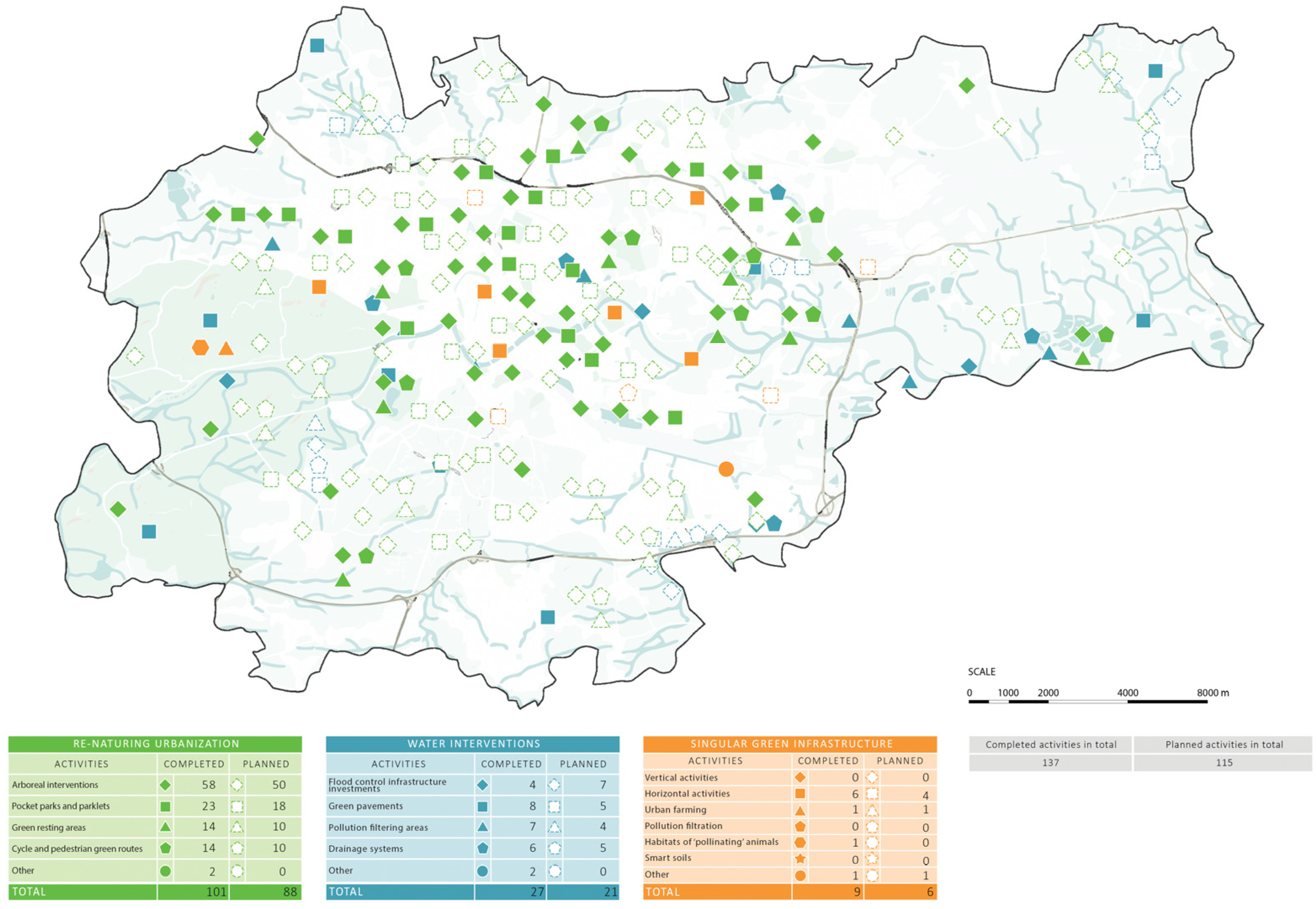
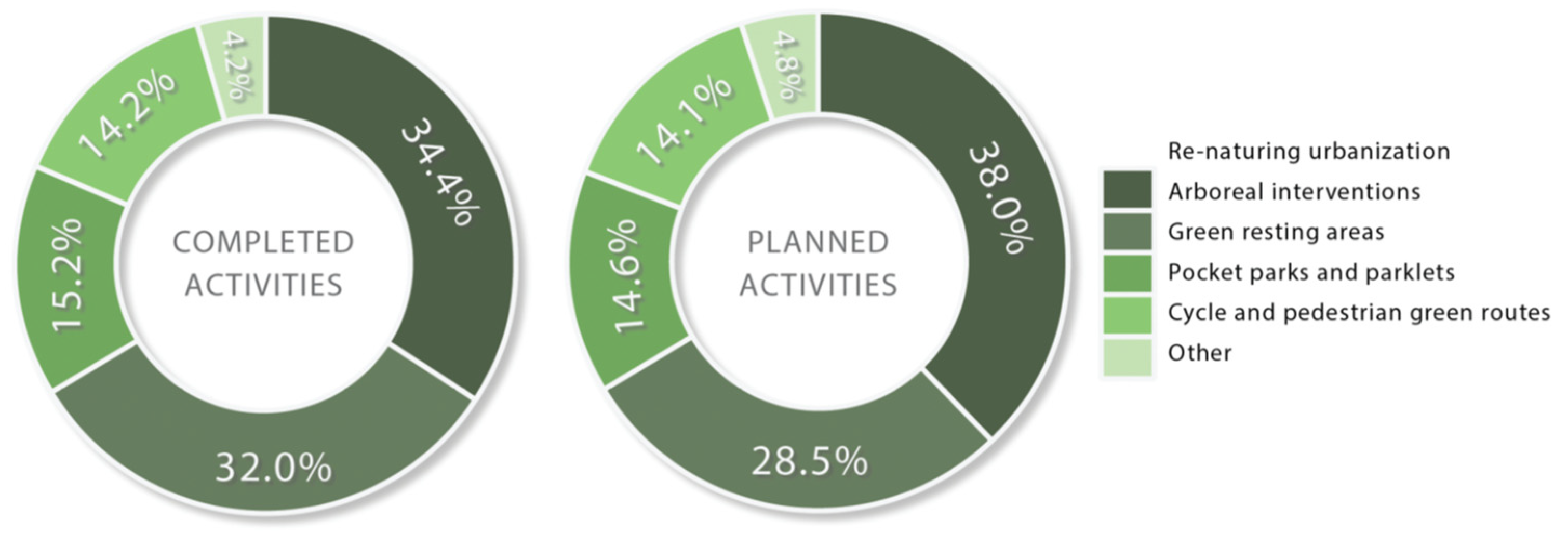
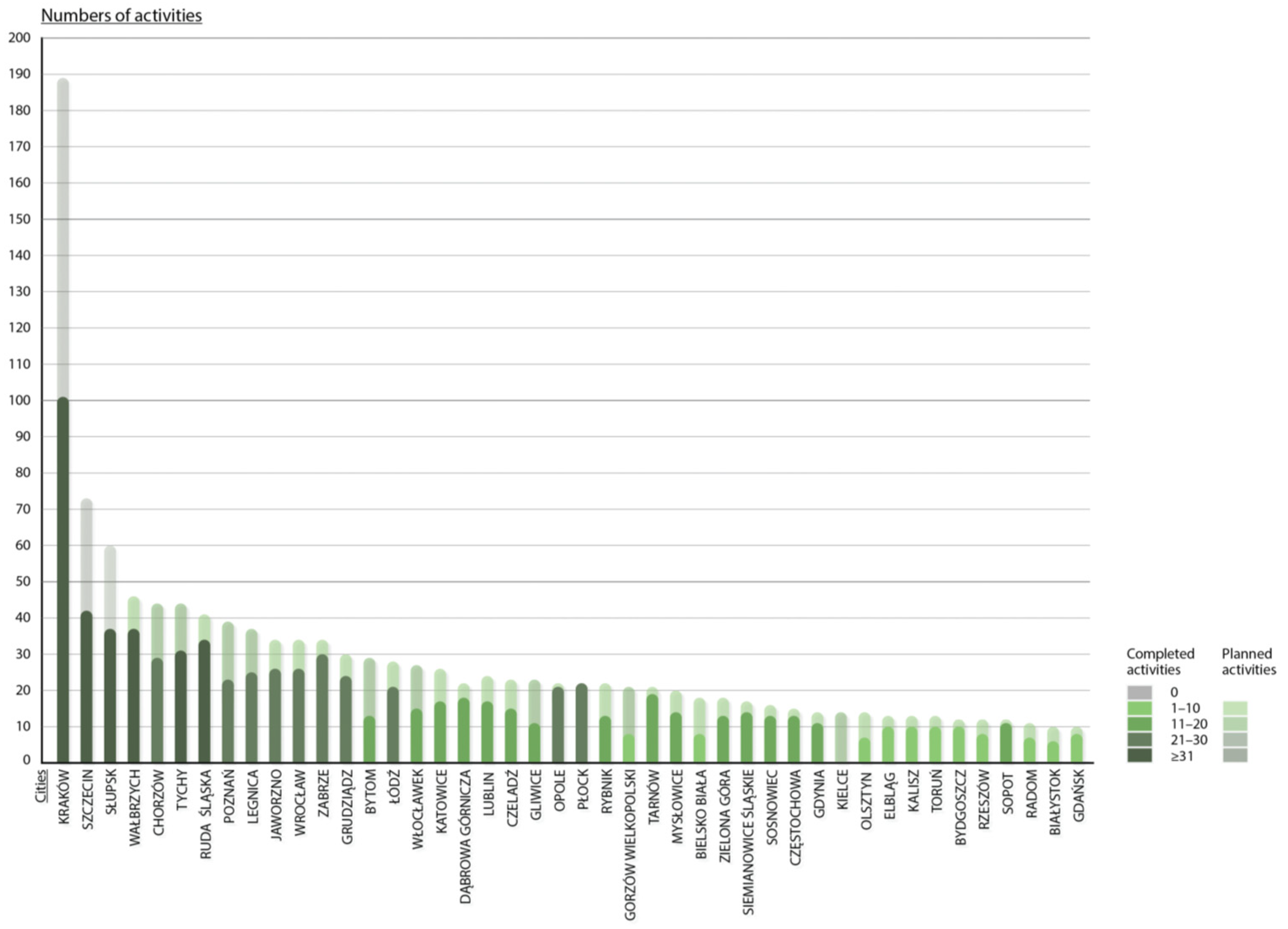

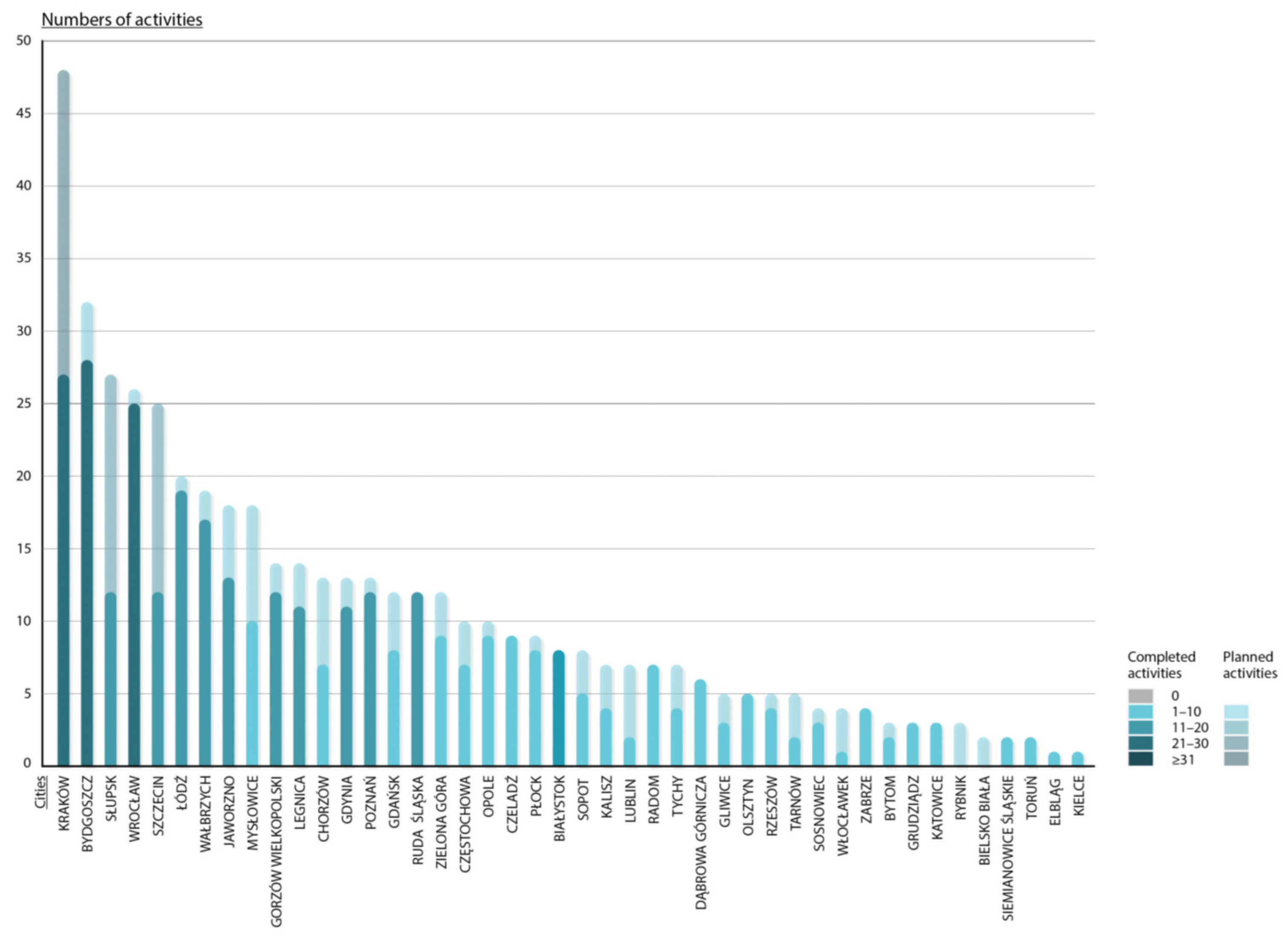
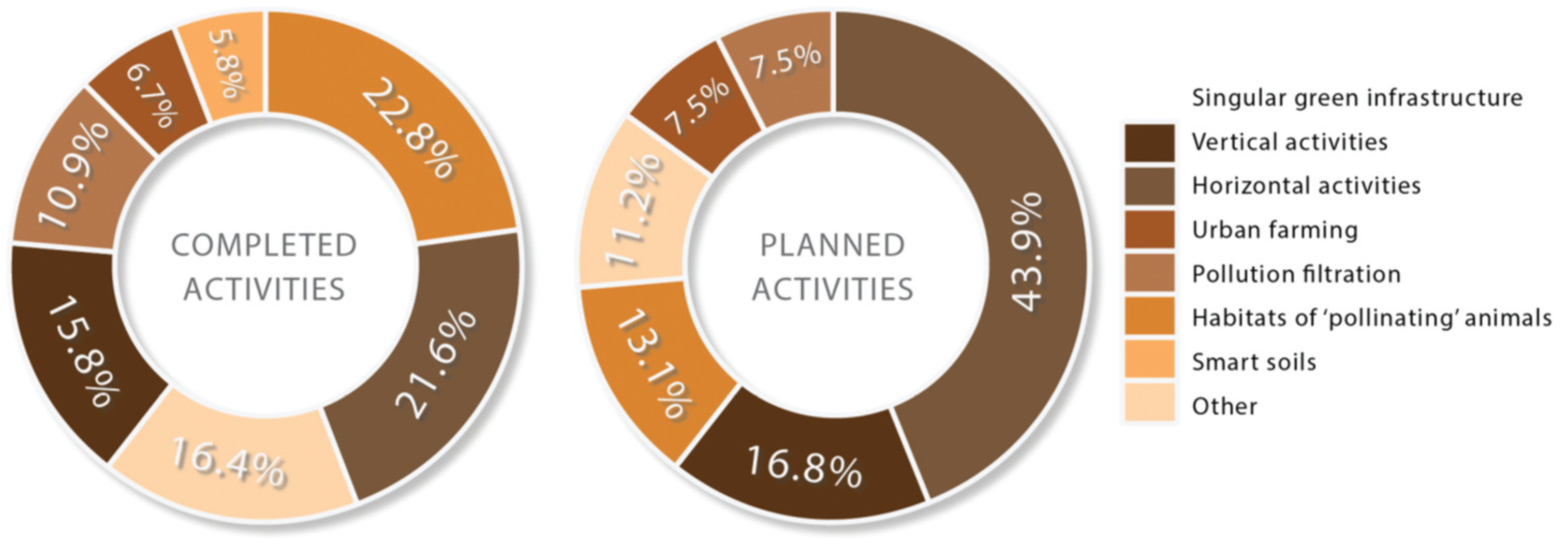
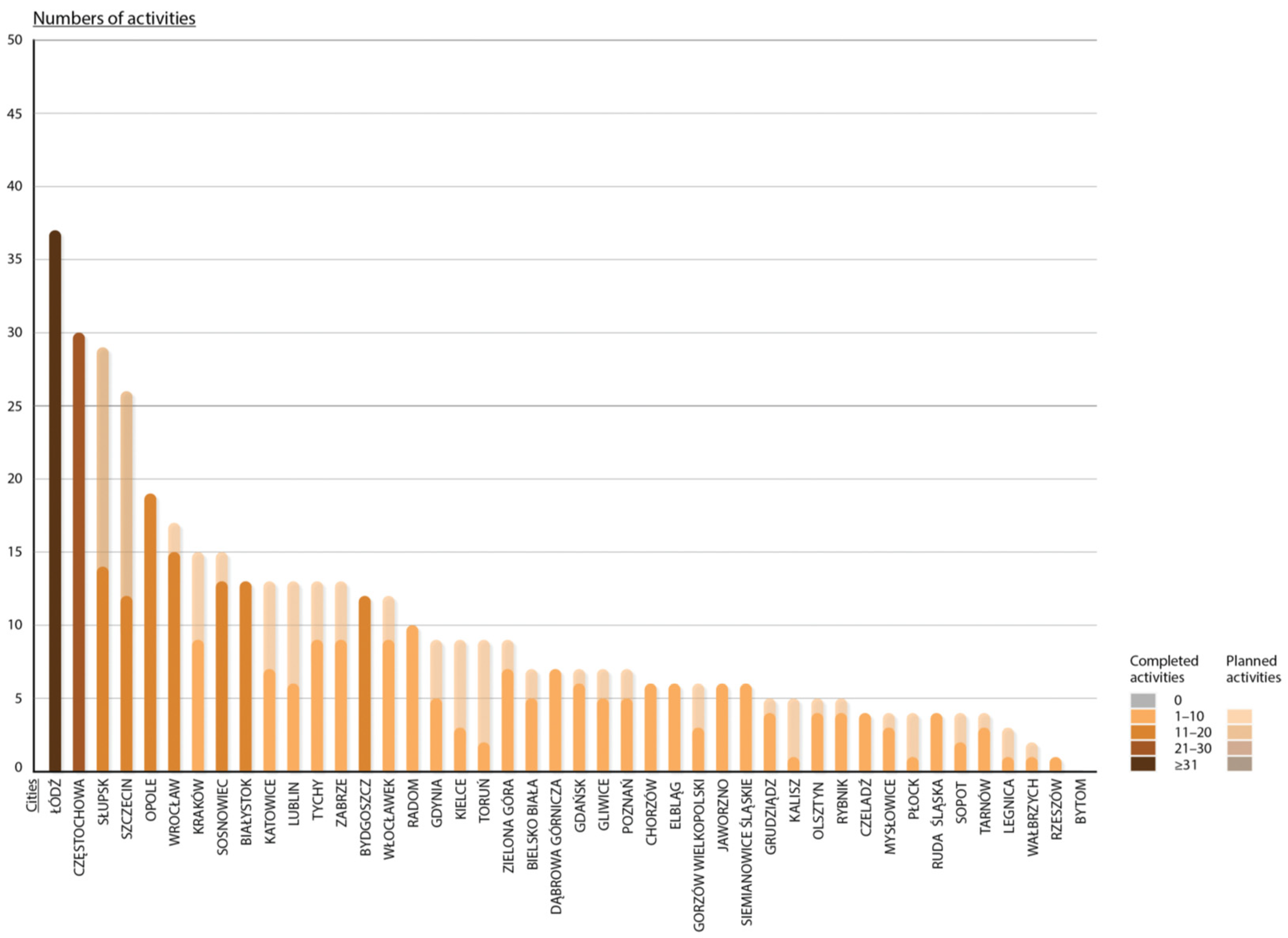
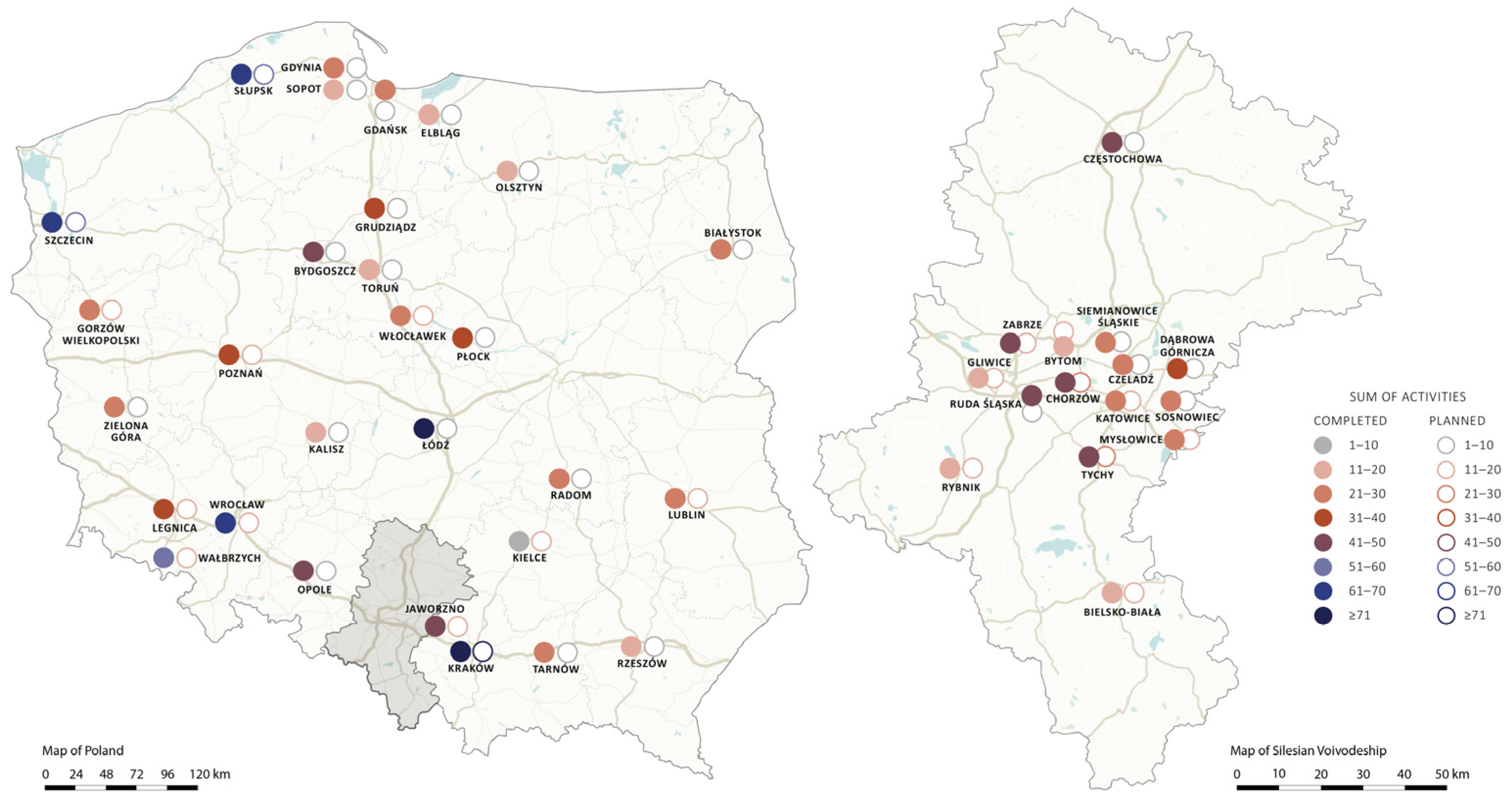

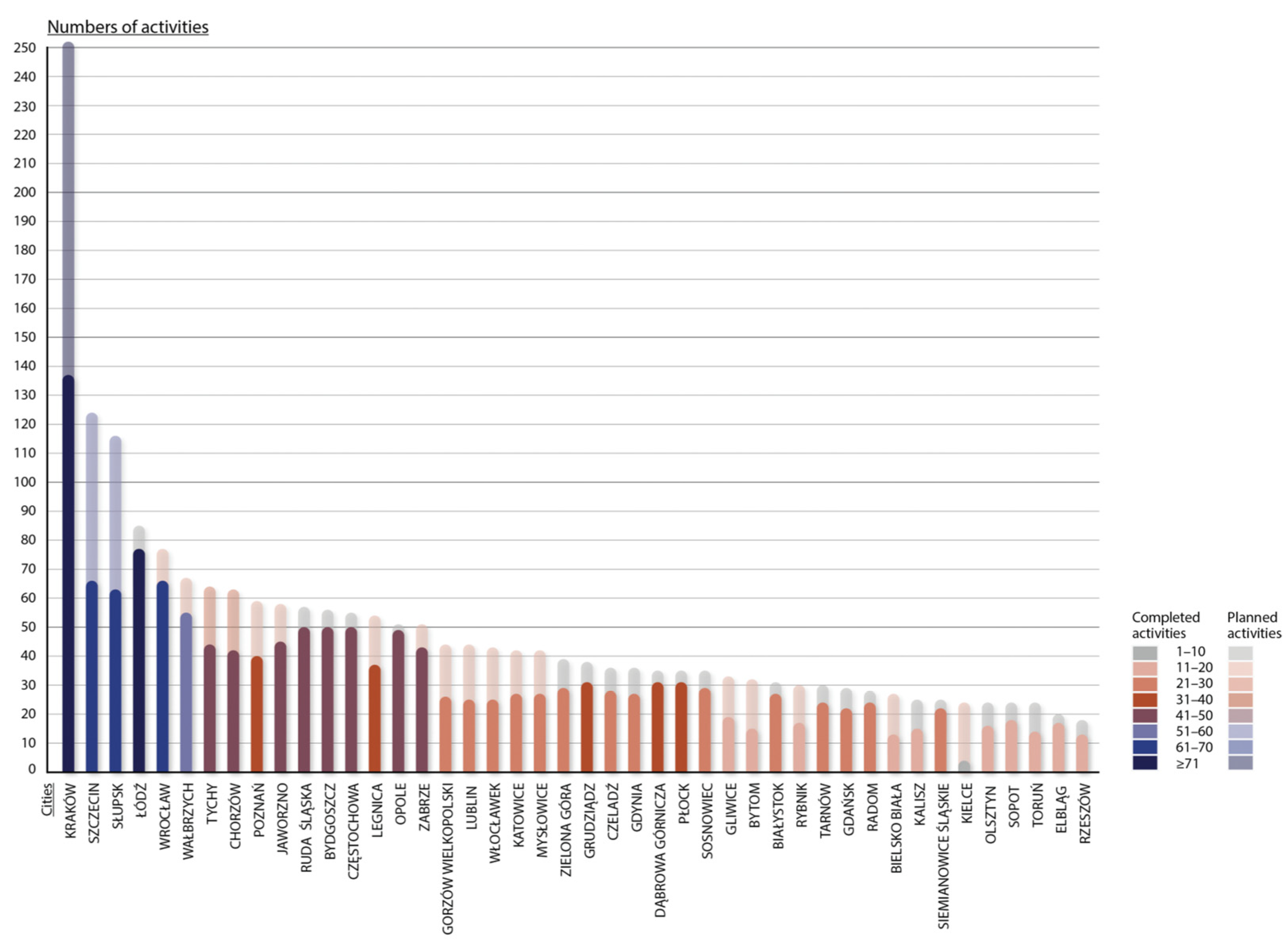
Disclaimer/Publisher’s Note: The statements, opinions and data contained in all publications are solely those of the individual author(s) and contributor(s) and not of MDPI and/or the editor(s). MDPI and/or the editor(s) disclaim responsibility for any injury to people or property resulting from any ideas, methods, instructions or products referred to in the content. |
© 2023 by the authors. Licensee MDPI, Basel, Switzerland. This article is an open access article distributed under the terms and conditions of the Creative Commons Attribution (CC BY) license (https://creativecommons.org/licenses/by/4.0/).
Share and Cite
Pancewicz, A.; Bednarz, D.; Drożdż, D.; Marszoł, M.; Suchy, N. The Use of Nature-Based Solutions in the Adaptation of Large Polish Cities to Climate Change and Energy Transformation: A Comparative Analysis. Energies 2023, 16, 5189. https://doi.org/10.3390/en16135189
Pancewicz A, Bednarz D, Drożdż D, Marszoł M, Suchy N. The Use of Nature-Based Solutions in the Adaptation of Large Polish Cities to Climate Change and Energy Transformation: A Comparative Analysis. Energies. 2023; 16(13):5189. https://doi.org/10.3390/en16135189
Chicago/Turabian StylePancewicz, Alina, Dominika Bednarz, Dawid Drożdż, Monika Marszoł, and Natalia Suchy. 2023. "The Use of Nature-Based Solutions in the Adaptation of Large Polish Cities to Climate Change and Energy Transformation: A Comparative Analysis" Energies 16, no. 13: 5189. https://doi.org/10.3390/en16135189
APA StylePancewicz, A., Bednarz, D., Drożdż, D., Marszoł, M., & Suchy, N. (2023). The Use of Nature-Based Solutions in the Adaptation of Large Polish Cities to Climate Change and Energy Transformation: A Comparative Analysis. Energies, 16(13), 5189. https://doi.org/10.3390/en16135189







